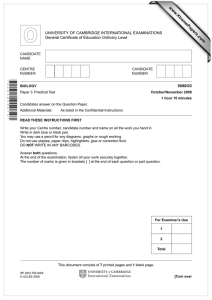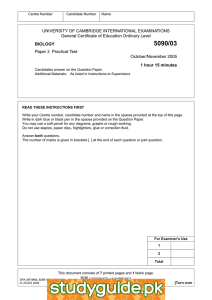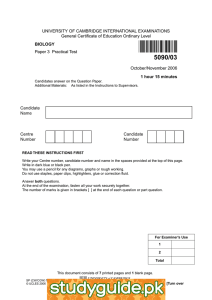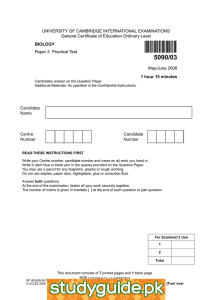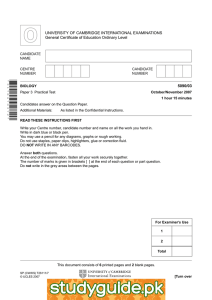UNIVERSITY OF CAMBRIDGE INTERNATIONAL EXAMINATIONS General Certificate of Education Ordinary Level 5090/03
advertisement
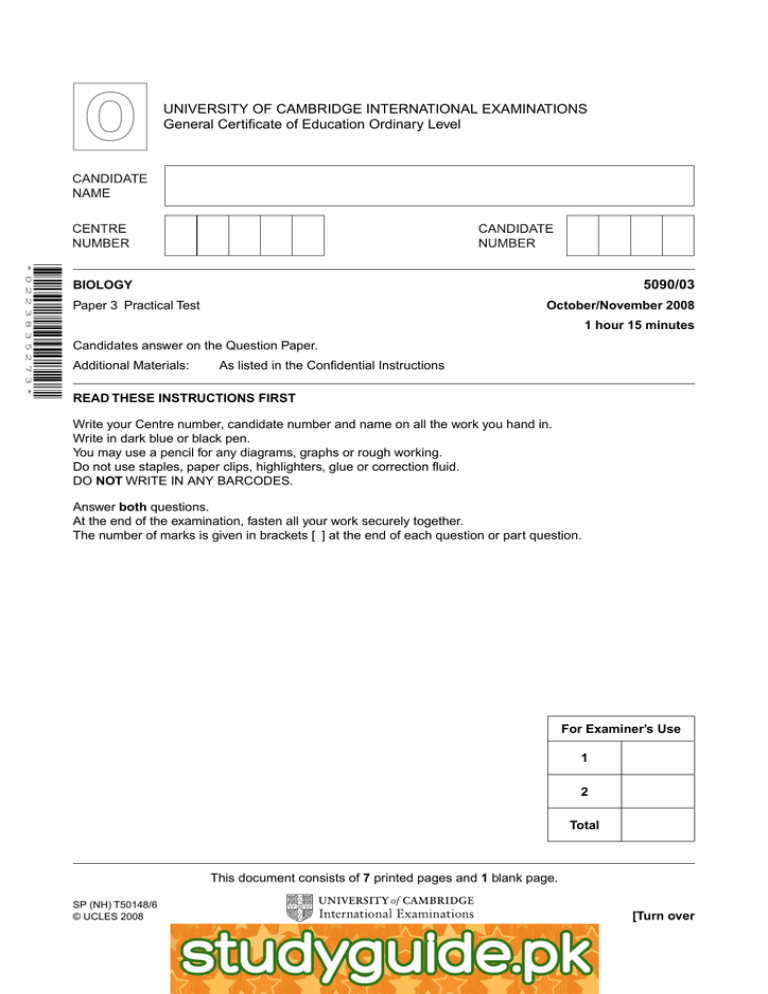
UNIVERSITY OF CAMBRIDGE INTERNATIONAL EXAMINATIONS General Certificate of Education Ordinary Level *0223835273* 5090/03 BIOLOGY Paper 3 Practical Test October/November 2008 1 hour 15 minutes Candidates answer on the Question Paper. Additional Materials: As listed in the Confidential Instructions READ THESE INSTRUCTIONS FIRST Write your Centre number, candidate number and name on all the work you hand in. Write in dark blue or black pen. You may use a pencil for any diagrams, graphs or rough working. Do not use staples, paper clips, highlighters, glue or correction fluid. DO NOT WRITE IN ANY BARCODES. Answer both questions. At the end of the examination, fasten all your work securely together. The number of marks is given in brackets [ ] at the end of each question or part question. For Examiner’s Use 1 2 Total This document consists of 7 printed pages and 1 blank page. SP (NH) T50148/6 © UCLES 2008 [Turn over www.xtremepapers.net 2 You are advised to read the whole question before starting. 1 You have been given two cups. These cups represent two animals cooling. • • • • • • • Cover all of the outside of one of the cups with paper tissue, cup A. Hold the paper securely round the cup with the two elastic bands. Use the pipette to squirt water from the beaker onto the tissue paper so that it is wet all over. Keep the tissue wet for the whole time of the experiment. Use the second cup just as it is, cup B. Ask the supervisor to fill both cups with hot water. (Take care: hot water) Take the temperature of the water in each cup. This is ‘zero’ time. Temperature in cup A = …….. • • • • • • • Temperature in cup B = ………. Cover the cups with the card ‘lids’ and replace the lid after every temperature reading. After exactly one minute take the temperature in cup A again. Exactly one minute later take the temperature in cup B. Record your readings in Table 1.1. Continue taking readings like this and record them in Table 1.1. If, at any time, the paper tissue appears to be getting dry, keep it wet by squirting on more water with the pipette, as you did earlier. Record the room temperature at end of experiment. = …………………. © UCLES 2008 5090/03/O/N/08 www.xtremepapers.net For Examiner’s Use 3 Table 1.1 time from start / minutes cup A temperature / °C For Examiner’s Use cup B temperature / °C 0 (zero time) 1 2 3 4 5 6 7 8 9 10 [3] (a) (i) Plot these results on the grid provided using the same axes for both curves. [5] © UCLES 2008 5090/03/O/N/08 www.xtremepapers.net [Turn over 4 (ii) Suggest how the curves would have continued if the temperatures had been taken for another 10 minutes. .................................................................................................................................. .................................................................................................................................. ..............................................................................................................................[2] (b) (i) Explain the physical processes that are taking place in this experiment, affecting the rate of cooling of cup A. .................................................................................................................................. .................................................................................................................................. ..............................................................................................................................[2] (ii) Describe how the human skin carries out a similar cooling process when the body becomes too hot. .................................................................................................................................. .................................................................................................................................. ..............................................................................................................................[2] (iii) Describe how the cooling process in humans differs from that of cup A. .................................................................................................................................. .................................................................................................................................. ..............................................................................................................................[2] (c) Suggest three ways in which the experiment could be modified to make the data more reliable. 1 ........................................................................................................................................ 2 ........................................................................................................................................ 3 ....................................................................................................................................[3] [Total : 19] © UCLES 2008 5090/03/O/N/08 www.xtremepapers.net For Examiner’s Use 5 BLANK PAGE © UCLES 2008 5090/03/O/N/08 www.xtremepapers.net [Turn over 6 2 (a) • • (i) Place the slice of banana, W1, on the white tile and use the cotton-wool bud to smear iodine solution on half of the upper surface of the banana. Examine both the stained and unstained parts of the upper surface of the banana. Make a large, clear drawing of this upper surface of the banana to show its structure. Labels are not required. [3] (ii) Draw part of the fruit wall (‘skin’, ‘peel’) of the banana, as seen through the hand lens, to show its pattern of veins (vascular bundles). Labels are not required. [3] © UCLES 2008 5090/03/O/N/08 www.xtremepapers.net For Examiner’s Use 7 (iii) Calculate the magnification of your drawing in (a) (i). Show clearly where you made a measurement on your drawing. Record your measurements and show all working clearly. Magnification = ………… [4] (b) • • (i) Treat specimen W2 with iodine solution in the same way as W1. Examine the specimen. State two ways in which the specimens can be seen to have a similar structure. 1 ................................................................................................................................ 2 ............................................................................................................................[2] (ii) Complete Table 2.1 to show three visible differences in the fruit wall (skin) of the two specimens. Table 2.1 specimen W1 specimen W2 1 2 3 [3] © UCLES 2008 5090/03/O/N/08 www.xtremepapers.net [Turn over For Examiner’s Use 8 (iii) Complete Table 2.2 to show two visible differences in the internal structure of the two specimens. For Examiner’s Use Table 2.2 specimen W1 specimen W2 1 2 [2] (c) The starch content of bananas decreases as the bananas ripen. Design, but do not try to carry out, an investigation to determine if this decrease in starch concentration results in an increase in the concentration of reducing sugars. .......................................................................................................................................... .......................................................................................................................................... .......................................................................................................................................... .......................................................................................................................................... .......................................................................................................................................... ......................................................................................................................................[4] [Total : 21] Permission to reproduce items where third-party owned material protected by copyright is included has been sought and cleared where possible. Every reasonable effort has been made by the publisher (UCLES) to trace copyright holders, but if any items requiring clearance have unwittingly been included, the publisher will be pleased to make amends at the earliest possible opportunity. University of Cambridge International Examinations is part of the Cambridge Assessment Group. Cambridge Assessment is the brand name of University of Cambridge Local Examinations Syndicate (UCLES), which is itself a department of the University of Cambridge. © UCLES 2008 5090/03/O/N/08 www.xtremepapers.net
